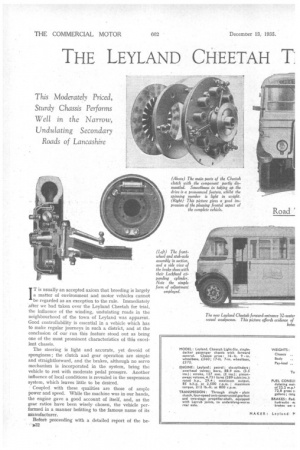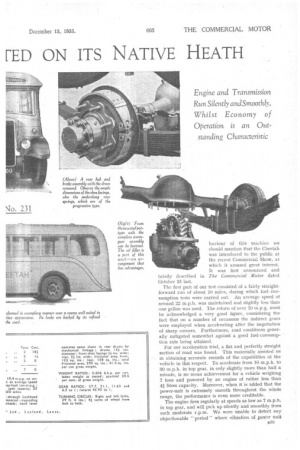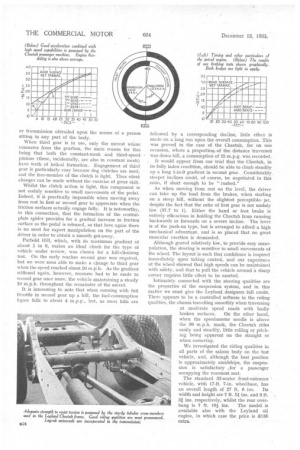THE LEYLAND CHEETAH T FED ON ITS NATIVE HEATH
Page 50

Page 51

Page 52

If you've noticed an error in this article please click here to report it so we can fix it.
IT is usually an accepted axiom that breeding is largely a matter of environment and motor vehicles cannot be regarded as an exception to the rule. Immediately after we had taken over the Leyland Cheetah for trial, the influence of the winding, undulating roads in the neighbourhood of the town of Leyland was apparent. Good controllability is essential in a vehicle which has to make regular journeys in such a district, and at the conclusion of our run this feature stood out as being one of the most prominent characteristics of this excellent chassis.
The steering is light and accurate, yet devoid of sponginess ; the clutch and gear operation are simple and straightforward, and the brakes, although no servo mechanism is incorporated in the system, bring the vehicle to rest with moderate pedal pressure. Another influence of local conditions is revealed in the suspension system, which leaves little to be desired.
: Coupled with these qualities are those of ample power and speed. While the machine was in our hands, the engine gave a good account of itself, and, as the gear ratios have been wisely chosen, the vehicle performed in a manner befitting to the famous name of its manufacturer.
Before proceeding with a detailed report of the be
• s32 haviour of this . machine we should mention that the Cheetah was introduced to the public at the recent Commercial Show, at which it aroused great interest. It was first announced and briefly described in The Commercial Motor dated October 25 last.
The first part of our test consisted of a fairly straightforward run of about 10 miles, during which fuel consumption tests were carried out. An average speed ot around 22 m.p.h. was maintained and slightly less than one gallon was used. The return of over 10 m.p.g. must be acknowledged a very good figure, considering the fact that on a number of occasions the indirect gears were employed when accelerating after the negotiation of sharp corners. Furthermore, road conditions generally mitigated somewhat against a good fuel-consumption rate being attained.
For our acceleration trial, a flat and perfectly straight section of road was found. This materially assisted us in obtaining accurate records of the capabilities of the vehicle in this respect. To accelerate from 10 m.p.h. to 30 m.p.h. in top gear, in only slightly more than half a minute, is no mean achievement for a vehicle weighing 7 tons and powered by an engine of rather less than 41 litres capacity. Moreover, when it is added that the power-unit is extremely smooth throughout the whole range, the performance is even more creditable. .
The engine fires regularly at speeds as low as 7 m.p.h. in top gear, and will pick up silently and smoothly from such moderate r.p.m. We were unable to detect any objectionable " period" where vibration of power unit or transmission obtruded upon the senses sitting in any part of the body. of a person When third gear is in use, only the merest whine emanates from the gearbox, the main reason for this being that both the constant-mesh and third-speed pinions (these, incidentally, are also in constant mesh) have teeth of helical formation. Engagement of third gear is particularly, easy because dog clutches are used, and the free-member of the clutch is light. Thus silent changes can be made without the. exercise of great skill.
Whilst the clutch action is light, this component is not unduly sensitive to small movements of the pedal. Indeed, it is practically impossible when moving away from rest in first or second gear to appreciate when the friction surfaces actually engage fully. It is noteworthy, in this connection, that the formation of the centralplate spider provides for a gradual increase in friction surface as the pedal is released, so that here again there is no need for expert manipulation on the part of the driver in order to obtain a smooth get-away.
Parbokl Hill, which, with its maximum gradient of about 1 in 8, makes an ideal climb for the type of vehicle under review, was chosen for a hill-climbing test. On the early reaches second gear was required, but we were soon able to make a change to third gear when the speed reached about 20 m.p.h. As the gradient stiffened again, however, recourse had to be made to second gear once more, the vehicle maintaining a steady 10 m.p.h. throughout the remainder of the ascent.
It is interesting to note that when running with full throttle in second gear up a hill, the fuel-consumption figure falls to about 4 m.p.g., but, as most hills are followed by a corresponding decline, little effect is made on a long run upon the overall consumption. This was proved in the case of the Cheetah, for on one occasion, where a proportion of the distance traversed was down hill, a consumption of 15 m.p.g. was recorded. . It would appear from our trial that the Cheetah, in its fully laden condition, should be able to climb steadily up a long 1-in-9 gradient in second gear. Considerably steeper inclines could, of course, be negotiated in this ratio, if short enough to be "rushed."
As when moving from rest on the level, the ,driver can take up the load from the brakes, when starting on a steep hill, without the slightest perceptible jar, despite the fact that the ratio of first gear is not unduly low (37.7 to 1). Either the hand or foot brake is entirely efficacious in holding-the Cheetah from running backwards or forwards on a severe incline. The lever is of the fiush-On type, but is arranged to afford a high mechanical advantage, and is so placed that no great muscular exertion is demanded.
Although geared relatively low, to provide easy manipulation, the steering is sensitive to small movements of the wheel. The layout is such that confidence is inspired immediately upon taking control, and our experience at the wheel showed that high speeds can be maintained with safety, and that to pull the vehicle around a sharp corner requires little effort to be exerted.
Intimately connected with the steering qualities are the properties of the suspension system, and in this matter we must give the Leyland designers full credit. There appears to be a controlled softness in the riding qualities, the chassis travelling smoothly when traversing at moderate speed roads with badly broken surfaces. On the other hand, when the speedometer needle is above the 30 m.p.h. mark, the Cheetah rides easily and steadily, little rolling or pitching being apparent on the straight or when cornering.
We investigated the riding qualities in all parts of the saloon body on the test vehicle, and, although the best position is approximately amidships, the suspension is satisfactory .,for a passenger occupying the rearmost seat.
The standard 32-seater front-entrance vehicle, with 17-ft. 7-in, wheelbase, has
an overall length of 27 ft. 6 ins. Its width and height are 7 ft. 51 ins. and 9 ft. 31 ins, respectively, whilst the rear overhang is 7 ft. l0 ins. The model, is available also with the Leyland oil engine, in which case the price is £135 extra.




































































































